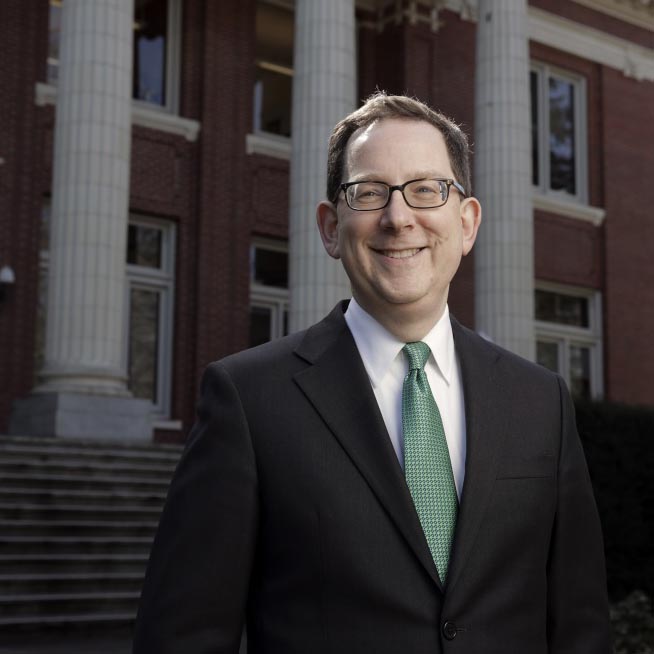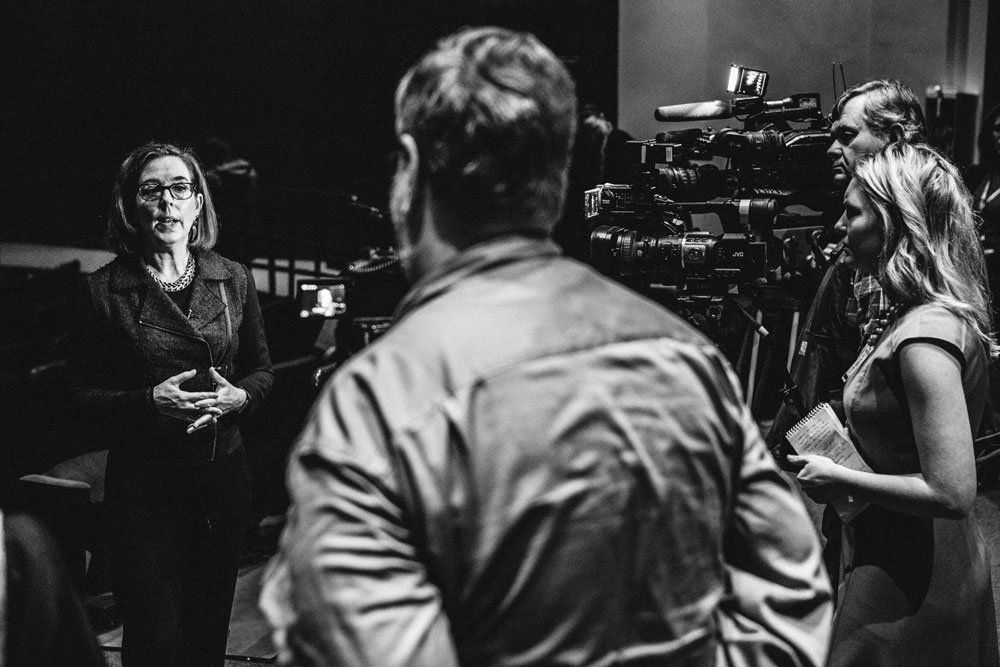On Oct. 6, 2017, University of Oregon President Michael Schill was scheduled to deliver the State of the University address when student activists occupied the stage demanding changes on campus.
Schill left the event 12 to 15 minutes after his speech was slated to begin — without addressing the students — and recorded his speech and delivered it to the university via email.
Three days later, Schill pitched an op-ed article to The New York Times. Through a public records request, Eugene Weekly received emails detailing Schill’s conversations with Natalie Shutler, an opinions editor at The New York Timesfor the newspaper’s On Campus blog.
The email conversations show a university president and an editor at The New York Times discussing the “irony” lost on the students as they protest university policy while shutting down speech — ultimately comparing students to fascists.
Through spokesman Tobin Klinger, Schill refused to comment on the op-ed to EW or to any local media outlets.
In his pitch to The New York Times, Schill wrote: “A small group of students shouted down a speech I was prepared to deliver on Friday.” Schill called the incident a “growing problem on campuses” that “deeply troubles” him.
On Oct. 23, Schill’s op-ed “The Misguided Student Crusade Against ‘Fascism’” appeared in The New York Times.
document
Click here to read emails between a New York Times opinion editor and Michael Schill
After Schill sent his first draft to Shutler, she suggested ideas that pointed out “offensive speech” on campus.
“It makes some very interesting points that show, broadly, the strain of obstructive activism on campus,” Shutler wrote.
“I was struck by the idea that these students would hurl the word ‘fascist’ at you, when they themselves are protesting offensive ideas,” she wrote. “I wonder if you could grapple more with the offensiveness (aside from the obvious stupidity) of the students’ calling you a fascist.”
Shutler did not respond to several emails or phone calls to The New York Timesfor comment.
In the same email, Shutler wrote that students calling Schill a “fascist” is “so ridiculous.”
“It’s a silly thing to say, but it’s well within their rights to say it. As long as they don’t shut me down. In an odd twist, the most fascist act of all is shutting down speech, but the irony is lost on them …” Shutler says, referring to students.
What these emails fail to discuss is the lengths the University of Oregon went through to use social media and media captured by journalists during the protests to identify students, send them disciplinary letters and ultimately charge them with violations of the student conduct code.
Michael Dreiling, a sociology professor and president of the UO Academics union, says students who received disciplinary letters after protesting were confused by the two options being offered by the Student Conduct and Community Standards Office.
The first option “was a route that didn’t result in any formal charges, though the way it was communicated, it sounded like people were being charged,” Dreiling says. “But the second option did produce allegations; it did result in reprimands with charges.”
Charlie Landeros, a member of the UO Student Collective, a student activist organization, was one of the several students who received a disciplinary letter. Landeros says they chose the second option — where students were given the opportunity to dispute the charges in a hearing.
According to Landeros, they attended a hearing where they argued they were not guilty of the charges alleged by the Student Conduct office. “They sent me another email a week later saying they found me guilty of the alleged charges, and right now I am in the appeals process, which is not really going that well.”
Landeros says they were heard by one person, Katy Larkin, associate director for Investigations and Group Accountability, Student Conduct and Community Standards, who they say found them guilty.
“The student conduct [code] says you’re allowed to bring relevant witnesses as well, yet I was denied that right. I wasn’t allowed to bring anyone in there,” Landeros says.
According to the university’s Student Conduct Code, “procedural protections” are in place for students who are accused of violating the code. Section E in the code states that students can expect “[t]o propose relevant witnesses and submit suggested questions to the Director.”
document
University of Oregon Public Records Request Documents
As several student protesters began to grapple with disciplinary letters accusing them of “failure to comply” and “disruption of university,” Shutler and Schill were discussing the response to Schill’s op-ed.
“Yes, it is getting a lot of attention,” Shutler wrote. “This is a tough topic and I thought you brought an interesting and compassionate angle to it. I’d love to get coffee in November. Would you mind stopping by the Times building in midtown?”
Schill and Vice President for University Communications Kyle Henley were in the Times building on Nov. 8, according to emails. “We are the two lost looking guys in suits in the cafeteria,” Henley wrote.
Members of the university faculty sent Schill emails and the faculty union drafted a letter condemning Schill’s op-ed and the treatment of student protesters.
“The president’s decision to make the issue highly public has politicized this case and undermined any semblance of due process for students,” Dreiling wrote. “It is very difficult to not see the president’s actions and the charges from your office as a very unwelcome form of targeted intimidation.”
Dreiling tells EW, “For our university president to go to The New York Times for this kind of issue, honestly was something that many people think was completely out of line, and it was doing nothing to support the principles of free speech, speech advocacy or academic freedom. It was if anything producing a silence or chilling effect on the right to assemble, and the right to speak out on issues in our public space.”
One student who received a disciplinary letter has yet to meet with the student conduct office because her meetings have been canceled twice.
“I don’t know what’s going on. Are they going to drop the charges or not?” asks Fama Gedi, a UO junior.
“I think they are trying to limit our freedom of speech,” she continues. “It’s just that simple. I think they are trying to scare us away from doing that or just from ever speaking against anything really. I don’t think it’s just the way we went about it. I don’t think they want to hear or care about students’ voices.”
EW also attempted to reach Natalie Shutler via Twitter, whose summary reads, “College kids, I’m tryin to hear from you.”






